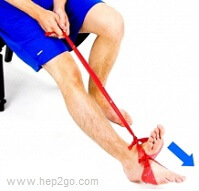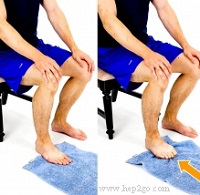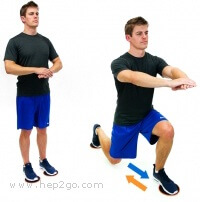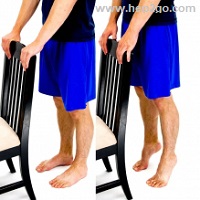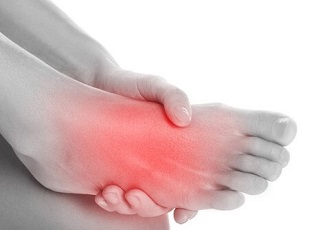- Home
- Foot & Ankle Exercises
Foot & Ankle Exercises
Written By: Chloe Wilson BSc(Hons) Physiotherapy
Reviewed By: FPE Medical Review Board
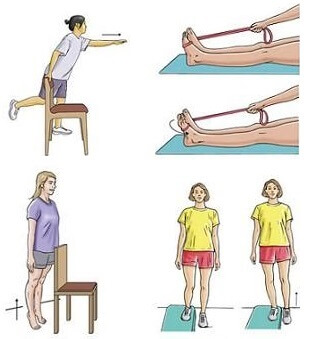
Foot and ankle exercises help to improve the strength, stability and mobility of the whole foot. They are one of the simplest yet most effective ways to relieve most causes of foot pain.
Any weakness, stiffness or tightness in the foot and calf can lead to a whole range of foot problems which can cause pain not only in the foot, but also the knee, hips and back.
Here you will find a whole range of foot and ankle exercises to choose from, depending on what you are trying to achieve. You will also find loads of great tips on how to get the best results from foot and ankle exercises.
Best Foot & Ankle Exercises
With foot and ankle exercises you want to do a combination of:
- Strengthening Exercises: To improve the strength and stability of the foot and ankle
- Stretching Exercises: To improve the mobility and flexibility
Often, people are looking to build-up general foot and ankle strength, stability and mobility, but if you have injured your foot, you would do better to have a specific exercise program for that injury - you'll find a whole range of these further on.
Strengthening Ankle Exercises
Strengthening the ankle and foot is helpful with virtually every cause of foot pain. Whether it is following an injury such as an ankle sprain or with a longer term foot problem, strengthening ankle exercises can make a big difference.
Here you will find a whole range of ankle exercises to improve the strength around the different parts of the foot. They work through three different types of strengthening exercise:
1. Static Ankle Strengthening
Static ankle exercises are a great way to strength the foot without having to move it i.e. the foot stays in a neutral position and doesn’t have to move. This makes it the perfect place to start after an injury or if you are getting pain when you move your foot without the risk of further damage.
You can find a whole program of static exercises in the foot and ankle strengthening section.
2. Resistance Band Exercises
Using a resistance band with ankle exercises give the foot something to push against. This is a great way to help build up the strength around the foot and ankle without putting too much force through it.
The most commonly used resistance bands are theraband – a sort of big elastic band to push against. It is available in different colours depending on how much resistance you want and is extremely strong and versatile.
Using resistance bands are a great way to add some variety to your ankle exercises and work in a similar way to weights.
You can find a whole range of resistance band exercises to improve strength and stability in the foot and ankle exercises section.
3. Dynamic Exercises
Dynamic ankle exercises use simple active movements such as picking up marbles with your toes to increase the strength of the foot. They are particularly good for strengthening the muscles under the foot that support the foot arches.
They don't take much effort and are really easy to do while you are sat down, but are super effective Learn More >
4. Calf Strengthening
Strengthening the calf muscles is an important component with ankle exercises.
The calf muscles start behind the knee and travel down the back of lower leg where they form the Achilles tendon and attach to the back of the heel. Weakness in the calf muscles affects both foot and knee movements as well as how the forces travel up the leg which can result in foot, ankle, knee, hip and back pain.
You will find a whole range of calf strengthening ankle exercises, and can choose from beginners, intermediate and advanced exercises, in the calf strengthening exercises section.
Foot & Ankle Stretches
Tightness in the muscles and stiffness in the joints around the foot can cause subtle changes to the position of the foot. This can again not only cause foot problems but also have a knock-on effect further up the leg.
Ankle stiffness is a common problem after injuries such as an ankle sprain and failure to regain full range of movement in the foot is the most common reason why symptoms persist for a long time after the injury has healed.
Foot and ankle stretches vary according to which part of the foot region you are trying to stretch:
1. General Stretches
General foot and ankle stretching exercise programs help to improve the flexibility of the ankle, foot and the toes. They target tightness in the muscles and stiffness in the joints. They are a great way to improve overall foot and ankle mobility.
You will find a whole program of exercises in the foot and ankle stretching exercises section.
2. Heel Stretches
Heel stretching exercises target both the Achilles tendon at the back of the heel and the plantar fascia underneath the heel. Tightness in either of these is a common cause of many foot problems, but responds well to simple exercises.
You can find a whole program of stretches for the heel region in the heel stretches section.
3. Calf Stretches
Tightness in the calf muscles leads to a whole host of foot and knee problems as it shifts the foot and knee out of position.
The calf is actually made up of two muscles:
- Gastrocnemius: Runs from just above the knee to the back of the heel
- Soleus: Runs from just below the knee to the back of the heel and sits underneath gastrocnemius
Effective calf stretching ankle exercises should target both muscles. You can find a whole range of exercises to stretch gastrocnemius and soleus in the Calf Stretches section.
Exercises For Specific Conditions
The ankle exercises programs we have looked at so far are great for improving the general strength, stability and flexibility at the ankle and foot. But if you have injured your foot or are having problems with ongoing ankle or foot pain or instability, it can help to have a more specific program tailored for the specific injury.
So we have developed some specific foot and ankle exercise programs for common foot problems.
1. Plantar Fasciitis Exercises
Plantar fasciitis is a really common foot problem caused by tightness, weakness and inflammation of the tissues underneath the foot. It tends to affect people who spend long periods on their feet or people who have suddenly increased their activity levels.
Foot and ankle exercises are one of the most effective treatments for plantar fasciitis, not only to treat the condition but to stop it from coming back as so often happens. Here you will find both strengthening and stretching exercises for plantar fasciitis.
More exercise programmes for specific foot conditions coming soon!
Knee Exercises
Lots of people who do ankle exercises are also looking for ways to strengthen their knee too as there is a really connection between our feet and knees.
Foot and ankle problems often result from weakness and tightness in the muscles further up the leg and in the buttocks. It may be hamstring tightness, particularly common in men, or glutes weakness, which can cause the foot arches to drop.
With any type of foot pain, the foot should not be looked at in isolation, it is important to look at the whole leg and even the lower back to see if problems further up are to blame. One out sister site, knee-pain-explained.com, you will find loads of knee exercises that can help with foot and ankle problems:
- Knee Strengthening Exercises: a whole range of strengthening exercises for the quads, hamstring, glutes and VMO muscles
- Knee Stretches: loads of stretching exercises for the knee muscles including the quads, hamstring, glutes and ITB
Top Tips For Exercising
Here are some of my top tips to get the best results from your foot and ankle exercises:
- Work at the Right Level: Ankle exercises should leave you feeling like you have worked hard, but shouldn’t cause any pain. Too easy and there won’t be much benefit, too difficult and you risk injuring yourself.
- Where to Start: With any exercises, start slow and gradually increase. Sometimes, particularly when we first start exercising, it feels ok at the time but a few hours later, you notice pain and stiffness. Next time, do a bit less. Decrease the number of ankle exercises or the number of repetitions until you find the right level for you.
- How To Progress: Once you’ve found the level that is right for you, stick at that for three days. Then, gradually increase how much you are doing, either increasing the number of repetitions, adding in another exercise or using weights. Only change one thing at a time.
- Follow the 10% Rule: You shouldn’t increase training by more than 10% each week else you risk injuring yourself. The muscles need time to get used to the extra work
- Safety: Always consult your doctor before starting a new exercise programme, particularly if you have sustained a foot injury or are recovering from surgery. Exercising too much or too soon could cause further damage
- Technique: Make sure you are doing the exercises correctly. Keep reading back over the instructions to check – it is so easy to do them slightly wrong which can stop you getting the best results. And remember, it is much better to do a lower number of exercises and do them correctly, than to cheat a little bit if they feel difficult.
Strengthening Exs | Stretches | Plantar Fascia Exs | Knee Exs
What Next?
Foot and ankle exercises are the best way to improve the strength, stability and flexibility in the feet and reduce foot pain and swelling.
Choose from the different sections above to find the right ankle exercises for you. But do remember, you should always check with your doctor before starting these exercises, particularly if you have suffered an injury or have any foot pain.
If you want some help working out what is causing your pain, visit the foot pain diagnosis section.
Related Articles
Page Last Updated: 09/12/23
Next Review Due: 09/12/24
